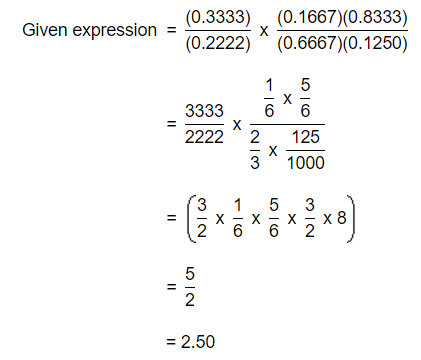All Exams >
UPSC >
CSAT Preparation >
All Questions
All questions of Fractions for UPSC CSE Exam
Evaluate:
- a)2
- b)4
- c)6
- d)8
Correct answer is option 'B'. Can you explain this answer?
Evaluate:
a)
2
b)
4
c)
6
d)
8

|
Lohit Matani answered |
Answer: Option B
Explanation:
Given Expression =
What decimal of an hour is a second ?- a).0025
- b).0256
- c).00027
- d).000126
Correct answer is option 'C'. Can you explain this answer?
What decimal of an hour is a second ?
a)
.0025
b)
.0256
c)
.00027
d)
.000126

|
Athul Saini answered |
Answer: Option C
Explanation:
Required decimal =1/(60*60)=1/3600= .00027
The expression (11.98 * 11.98 + 11.98x + 0.02 * 0.02) will be a perfect square for x equal to:- a)0.02
- b)0.2
- c)0.04
- d)0.4
Correct answer is option 'C'. Can you explain this answer?
The expression (11.98 * 11.98 + 11.98x + 0.02 * 0.02) will be a perfect square for x equal to:
a)
0.02
b)
0.2
c)
0.04
d)
0.4

|
Sneha Kumar answered |
Answer: Option C
Explanation:
Given expression = (11.98)2 + (0.02)2 + 11.98 x x.
For the given expression to be a perfect square, we must have
11.98 x x = 2 x 11.98 x 0.02 or x = 0.04
If 2994 ÷ 14.5 = 172, then 29.94 ÷ 1.45 = ?- a)0.172
- b)1.72
- c)17.2
- d)172
Correct answer is option 'C'. Can you explain this answer?
If 2994 ÷ 14.5 = 172, then 29.94 ÷ 1.45 = ?
a)
0.172
b)
1.72
c)
17.2
d)
172

|
Athul Saini answered |
Answer: Option C
Explanation:
The value of
- a)0.86
- b)0.95
- c)0.97
- d)1.06
Correct answer is option 'A'. Can you explain this answer?
The value of
a)
0.86
b)
0.95
c)
0.97
d)
1.06

|
Amrita Bose answered |
Answer: Option A
Explanation:

- a).0009
- b).09
- c).9
- d)9
Correct answer is option 'C'. Can you explain this answer?
a)
.0009
b)
.09
c)
.9
d)
9

|
Akanksha Ahuja answered |
Answer: Option C
Explanation:
3889 + 12.952 - ? = 3854.002- a)47.095
- b)47.752
- c)47.932
- d)47.95
Correct answer is option 'D'. Can you explain this answer?
3889 + 12.952 - ? = 3854.002
a)
47.095
b)
47.752
c)
47.932
d)
47.95

|
Ameya Ahuja answered |
Answer: Option D
Explanation:
Let 3889 + 12.952 - x = 3854.002.
Then x = (3889 + 12.952) - 3854.002
= 3901.952 - 3854.002
= 47.95.

- a)2
- b)2.40
- c)2.43
- d)2.50
Correct answer is option 'D'. Can you explain this answer?
a)
2
b)
2.40
c)
2.43
d)
2.50

|
Ameya Ahuja answered |
Answer: Option D
Explanation:
The value of 
- a)0.0125
- b)0.125
- c)0.25
- d)0.5
Correct answer is option 'B'. Can you explain this answer?
The value of
a)
0.0125
b)
0.125
c)
0.25
d)
0.5

|
Athul Saini answered |
Answer: Option B
Explanation:
Chapter doubts & questions for Fractions - CSAT Preparation 2025 is part of UPSC CSE exam preparation. The chapters have been prepared according to the UPSC CSE exam syllabus. The Chapter doubts & questions, notes, tests & MCQs are made for UPSC CSE 2025 Exam. Find important definitions, questions, notes, meanings, examples, exercises, MCQs and online tests here.
Chapter doubts & questions of Fractions - CSAT Preparation in English & Hindi are available as part of UPSC CSE exam.
Download more important topics, notes, lectures and mock test series for UPSC CSE Exam by signing up for free.

Contact Support
Our team is online on weekdays between 10 AM - 7 PM
Typical reply within 3 hours
|
Free Exam Preparation
at your Fingertips!
Access Free Study Material - Test Series, Structured Courses, Free Videos & Study Notes and Prepare for Your Exam With Ease

 Join the 10M+ students on EduRev
Join the 10M+ students on EduRev
|

|
Create your account for free
OR
Forgot Password
OR
Signup on EduRev and stay on top of your study goals
10M+ students crushing their study goals daily









